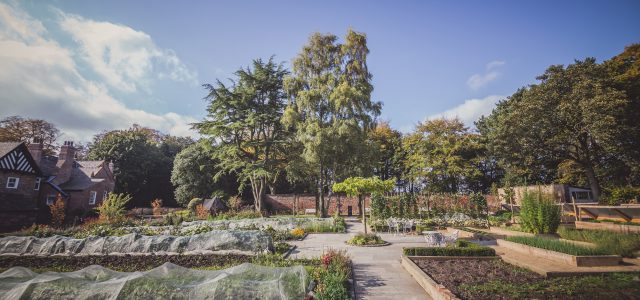
Winning Ways
With Lockdown Veg
Has this spring’s gardening frenzy left you overwhelmed with produce? Stephanie Sparrow gathers recipe and pickling inspiration
When the going gets tough, the British get growing. Our enthusiasm for homegrown fruit and vegetables was last cultivated in the Second World War by Minister of Food and pioneer of rationing Lord Woolton, and by propaganda shots of the young princess Elizabeth tending vegetable plots at Windsor Castle.
Since this spring’s lockdown, backyards and gardens have burst into life, and demand for allotments has soared. The Royal Horticultural Society reports a five-fold increase in requests for advice and seedsmen have had a bumper year.
Now we are harvesting the fruits, and vegetables, of our labours. But what are we going to do with it all? Freezing is one option, but trying cooking up something creative, says Mike Bryan, proprietor of The Bees Country Kitchen at Chorley covered market.
Among the suggestions from Mike, a finalist in the BBC Food and Farming Awards, are vegetable kebabs for the barbecue, or substituting thinly sliced lengths of courgettes for sheets of lasagne.
“Spare veg can be roasted in a little spray oil, seasoned and added cold to a salad with harissa paste and couscous, or to passata and sautéed onions for a pasta sauce,” says Mike.
Be brave with green beans too. “Boil briefly then add to a hot frying pan with a little oil, mustard seeds and black onion seeds for a nice accompaniment to a curry,” he says.
Not every vegetable has to be a showstopper. “Add small diced veg to bulk out spaghetti Bolognese or chilli,” says Mike.
Homemade pickles and chutneys will also make the most of your crop and build a winter store cupboard. During WW2 Lord Woolton encouraged pickling expert Henry Sarson (the vinegar magnate) to produce a thrifty recipe book. The simply named Home Pickling was reprinted throughout WW2, and my late grandmother snapped up her copy in 1942 for one shilling and sixpence.
Faced with my own glut of homegrown vegetables I turned to Home Pickling for advice. I learnt that simple equipment is sufficient, cook in stainless steel saucepans and store in sterilised, air-dried jam jars. I also read that any garden produce, from cherries to marrows can be boiled with spices or vinegar to make a pickle, chutney or ketchup (the word ketchup has nothing to do with tomatoes, it is Chinese for sauce says Henry).
My wartime beetroot chutney was a success. Flavoured with allspice, salt, pepper, onions, sugar, and raisins it has used up my glut of beetroot. One tip however, boiled malt vinegar is very pungent. Henry Sarson recommended opening every window when cooking, but next time I’ll ditch the malt for a gentler product such as cider vinegar.
Back in the garden, newly confident growers could progress to items which are difficult to find or expensive in the supermarket, says Catherine Butters, head gardener and grower at Moor Hall Restaurant with Rooms in Aughton.
Catherine who uses the one-acre Walled Garden and its glass houses to supply the two Michelin star restaurant and casual Barn with specialised produce and garnishes, suggests planting globe courgettes, or fennel as a next step. “Or try raspberries which can be expensive in a punnet but are reasonably priced when bought as canes and planted in the spring”, she says.
NORTHERN HIGHLIGHTS
Pickles and chutneys are not just a British store cupboard favourite.
Scandinavian countries preserve berries and vegetables ahead of their long winters, a tradition celebrated at Mathilde’s Cafe in Grasmere.
Managing director Becky Heaton Cooper, who runs the cafe alongside the Heaton Cooper Studio (gallery), is the great granddaughter of Bolton’s famous landscape artist Alfred Heaton Cooper and his Norwegian wife Mathilde Valentinsen.
The menu draws on this Lancashire, Cumbrian and Norwegian heritage: dishes include slow-cooked beef, Scandinavian fishcakes, and meatballs served with berries.
“Some of our recipes have been in my family for generations”, says Becky.
“For example, our simple pickling recipe warms apple cider vinegar with lots of sugar, then adds vegetables. We make our sauerkraut by salting the cabbage with aromats and leaving it at 18 degrees for 10 days, before storing it in airtight bags to continue the fermentation process for eight to 10 weeks.
Becky suggests that vegetables with a lower starch content are most suitable for pickling. “Cauliflower, beetroot and carrots all pickle well,” she says.
All chefs have favourite pickling vinegars and flavourings. “I suggest malt, apple, white wine, or a basic white vinegar. Spices such as allspice, bay, cloves, juniper, mustard seeds and dill seeds work well,” says Becky.

